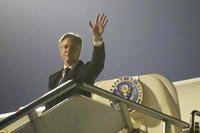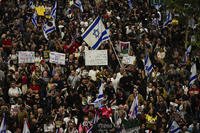Claims there has been a serious drop in military absentee ballot requests since the 2008 presidential election are false, says the former head of the Pentagon’s voter assistance program.
Robert H. Carey Jr., who headed the Federal Voter Assistance Program for the Defense Department from 2009 until earlier this year, says he understands concern and skepticism about Pentagon assurances.
“But simply because it is easy to believe the [DoD] is asleep on watch, or even worse, is actively suppressing military voting, does not make it so,” Carey said.
Carey maintains that while the overall 2008 figures are very high, they are meaningless for a side-by-side comparison with the 2012 numbers. That’s because 2012 absentee ballots going out are all responses to voter requests; those mailed out for 2008 included tens of thousands of robo-ballots automatically generated from an earlier list.
Carey called it “a subtle but analytically fatal flaw” in a recent report blasting the Pentagon’s efforts to get absentee ballots into the hands of servicemembers.
Carey is intimately familiar with military voting issues. In 27 years in the Navy and Naval Reserves, with active-duty call-ups, he experienced “disenfranchisement,” he said, by not always being able to get a vote cast. Later, he studied military voter problems as a senior fellow and then executive director of the National Defense Committee in Washington. He left the NDC to oversee the Pentagon’s voting assistance program.
The Military Voter Protection Project, a watchdog organization, announced in late September that military absentee ballot applications are down dramatically from 2008: by 70 percent in both Virginia and Ohio, and 47 percent in Florida. Executive Director Eric Eversole placed the blame on “bureaucratic inertia” within the Defense Department.
“There’s a lack of any strong structure that encourages service members to vote,” The Washington Times quoted him as saying. In a statement on the MVPP website, Eversole stated: “The people who are on the front lines defending freedom are in danger of having their voices silenced.”
Pam Mitchell, Carey’s successor at FVAP, insists the Pentagon is doing all it can to help military personnel and their family members vote. In one recent conference call with reporters, she conceded that the number of ballot registration and request forms downloaded from FVAP are lower than in 2008, but said 2008 was an unusual year for voter turnout because of Barack Obama’s candidacy.
According to Carey, the problem is not the Pentagon and it’s not flagging voter interest, but MVPP’s analysis.
MVPP either missed or ignored the fact that under the law in effect for 2008, election officials were required to send out thousands more ballots than were actually requested. At the time, the law mandated that absentee ballots be sent out to those who submitted a current ballot application and also to anyone who had applied for an absentee ballot in the prior election, 2006.
That was bound to create a significant spike in the number of ballots mailed out, according to Carey. Trouble is, some of it was illusory.
Carey said he has known Eversole for a long time. He is a strong advocate for military voting rights, he said, and the two of them have testified together before Congress on voting issues.
Carey does not know why MVPP did not factor in the automatically generated absentee ballots in its analysis.
“I pointed this out to Eric before. He was not interested,” Carey said.
Eversole did not respond to Military.com’s request for an interview.
Carey said the law requiring ballots be automatically sent to individuals who had applied for them in the election just previous was intended to better assure that military voters had a chance to vote.
But state and local officials lobbied successfully to repeal that law, Carey said, pointing out that a large number of ballots they sent out for 2008 came back as undeliverable or not at all.
Today, those robo-ballots are the reason 2008 military absentee voting looked so strong in comparison to 2012 figures, according to Carey’s analysis.
Carey points out that of the 41,762 absentee ballots Virginia mailed out for the 2008 election, only 12,858 were requested. The other 28,904 -- 69 percent of the total -- were mailed out to people whose names were still on the application list for the 2006 election.
In Florida, 121,395 absentee ballots were mailed out for the 2008 election. Fewer than half -- 54, 415 -- were requested; the others automatically went into the mail based on the 2006 list.
To make a valid comparison between 2008 and 2012, Carey says you must first strip from the 2008 totals the non-requested absentee ballots. That changes everything.
For Virginia, rather than the 70 percent drop MVPP found, 2012 already shows an increase of 28 percent over 2008. That’s based on 12,292 requested military and overseas ballots having gone out by Sept. 22 -- 45 days before next month’s election. At the same 45-days-out point in 2008, just 10,041 requested ballots had gone out.
Florida is another example. MVPP says military absentee ballot applications are down 47 percent from four years ago in the Sunshine State. But 45 days out from next month’s election, Florida had mailed out 65,173 ballots in response to voter requests; four years ago, at the same point, it had mailed out just 54,415 requested ballots.
To date, Florida is seeing a 20 percent increase in requested applications over 2008, according to Carey.




























